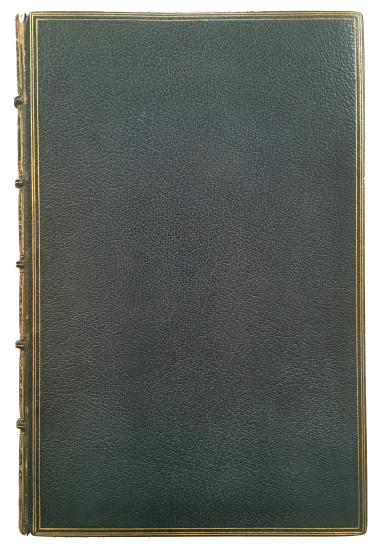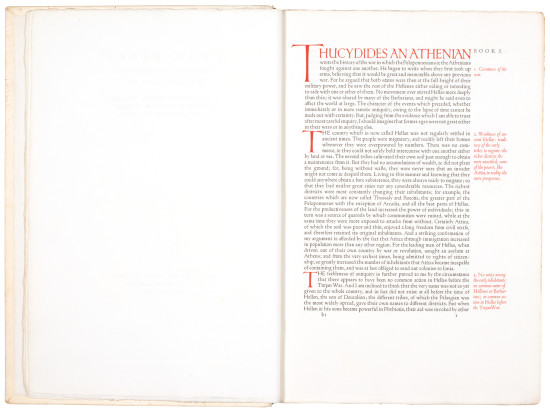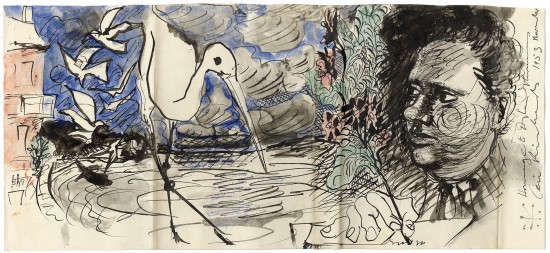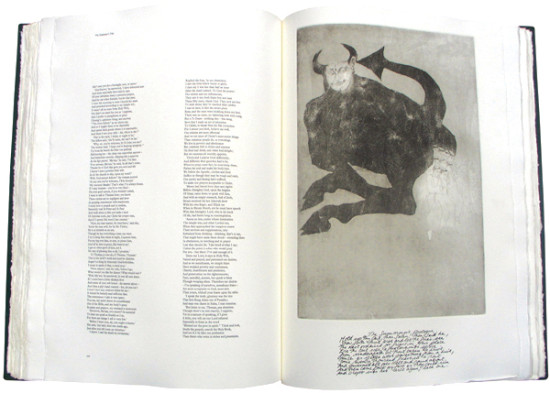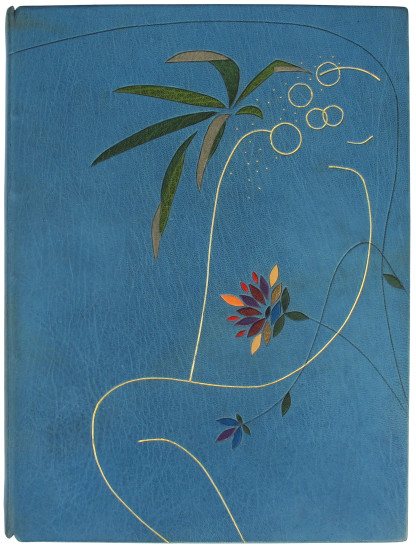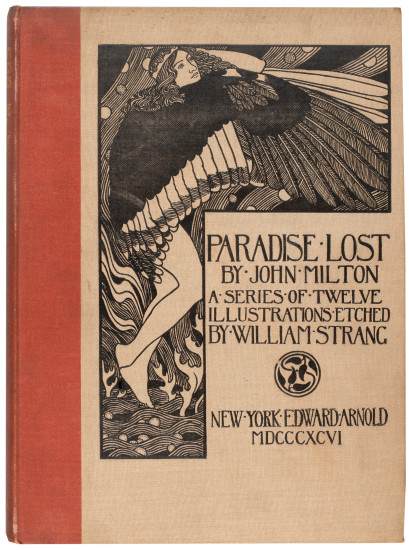Keats. (Poems)
Doves Press. Keats, John
Hammersmith. Doves Press. 1914
A very scarce copy of the vellum issue of the Doves Press' Keats in a highly accomplished binding of red morocco by Frieda Thiersch.
From the edition limited to 212 copies, with this one of 12 examples printed on vellum.
Apprenticed to the binder Charles McLeish who described her as the 'most skillful pupil we ever had ... equal to any professional', Frieda Thiersch (1889- 1947) was a prodigy: a highly talented, innovative and controversial binder. The daughter of a distinguished Munich-based architect, Frieda had a privileged upbringing before her seduction by her music master Ludwig Hess for a bet; the ensuing pregnancy caused her banishment to France for the birth of her child to avoid scandal. After the birth she was sent to London where she undertook an apprenticeship at McLeish & Sons that led to their endorsement and laid the foundations for her future as a binder.
Thiersch clearly absorbed, along with the binding skills and knowledge of the McLeishs, the influence of the Doves Bindery: Charles McLeish Sr. had worked with Cobden-Sanderson from 1893 until the establishment of his own bindery in 1909. The austere but beautiful work with the emphasis on simple clarity with a highly restrained decor became a feature of Thiersch's own work and the signature of the many bindings designed by her and issued by the Bremer Press - she worked as the principal designer and her atelier was the principal bindery for the press - before the worsening economic situation in the late 1920s / early 1930s caused the press to close. Throughout the time she worked with the Bremer Press, Thiersch took commissions in her own right as the present binding, signed with her full name as opposed to her initials (when produced by an assistant) and likely produced in the late 1920s, attests.
Thiersch exhibited her work internationally and showed books at the First Edition Club in London in 1929 (it is tempting to think that this binding was shown there), the World Exhibition in Barcelona in the same year, the Milan Triennale in 1930, 1933 and 1936 where she was awarded a gold medal and the Paris World Exhibition in 1937 where she was awarded another gold medal. Later in the 1930s Thiersch became associated with the German political establishment and undertook government contracts for the Nazis. Although she did execute personal commissions for, among others, Hitler, her own political views have never been established. The destruction of her archive and personal collection in a bombing raid in 1944, her death from lung cancer in 1947 and the confusion of the Second World War itself have ensured that both an aura of mystery has surrounded her work while adhering a considerable bibliophile cachet to it.
Although Thiersch's bindings for the Bremer Presse are prized, even more so are the bindings that she undertook on commission. We can trace few of these, but notable examples are the luxusausgabe of 'Das Graphische Werk Max Pechsteins' (1921), Johanne Auerbach's 'Summa de Auditione Confessionis et de Sacramentis' (the second or third book printed in Augsburg probably in 1469 or 1470), Georg Martin Richter's unique copy of Thomas Mann's 'Walsengenblut' (1921) and Franz Liszt's copy of the first edition of Baudelaire's 'Les Paradis Artificiels' with a presentation from the author among others.
[Tidcombe DP36; Tomkinson 58, 45].
From the edition limited to 212 copies, with this one of 12 examples printed on vellum.
Apprenticed to the binder Charles McLeish who described her as the 'most skillful pupil we ever had ... equal to any professional', Frieda Thiersch (1889- 1947) was a prodigy: a highly talented, innovative and controversial binder. The daughter of a distinguished Munich-based architect, Frieda had a privileged upbringing before her seduction by her music master Ludwig Hess for a bet; the ensuing pregnancy caused her banishment to France for the birth of her child to avoid scandal. After the birth she was sent to London where she undertook an apprenticeship at McLeish & Sons that led to their endorsement and laid the foundations for her future as a binder.
Thiersch clearly absorbed, along with the binding skills and knowledge of the McLeishs, the influence of the Doves Bindery: Charles McLeish Sr. had worked with Cobden-Sanderson from 1893 until the establishment of his own bindery in 1909. The austere but beautiful work with the emphasis on simple clarity with a highly restrained decor became a feature of Thiersch's own work and the signature of the many bindings designed by her and issued by the Bremer Press - she worked as the principal designer and her atelier was the principal bindery for the press - before the worsening economic situation in the late 1920s / early 1930s caused the press to close. Throughout the time she worked with the Bremer Press, Thiersch took commissions in her own right as the present binding, signed with her full name as opposed to her initials (when produced by an assistant) and likely produced in the late 1920s, attests.
Thiersch exhibited her work internationally and showed books at the First Edition Club in London in 1929 (it is tempting to think that this binding was shown there), the World Exhibition in Barcelona in the same year, the Milan Triennale in 1930, 1933 and 1936 where she was awarded a gold medal and the Paris World Exhibition in 1937 where she was awarded another gold medal. Later in the 1930s Thiersch became associated with the German political establishment and undertook government contracts for the Nazis. Although she did execute personal commissions for, among others, Hitler, her own political views have never been established. The destruction of her archive and personal collection in a bombing raid in 1944, her death from lung cancer in 1947 and the confusion of the Second World War itself have ensured that both an aura of mystery has surrounded her work while adhering a considerable bibliophile cachet to it.
Although Thiersch's bindings for the Bremer Presse are prized, even more so are the bindings that she undertook on commission. We can trace few of these, but notable examples are the luxusausgabe of 'Das Graphische Werk Max Pechsteins' (1921), Johanne Auerbach's 'Summa de Auditione Confessionis et de Sacramentis' (the second or third book printed in Augsburg probably in 1469 or 1470), Georg Martin Richter's unique copy of Thomas Mann's 'Walsengenblut' (1921) and Franz Liszt's copy of the first edition of Baudelaire's 'Les Paradis Artificiels' with a presentation from the author among others.
[Tidcombe DP36; Tomkinson 58, 45].
[102 leaves; pp. 203]. Large 8vo. (234 x 168 mm). Title, leaf with explanation, verso and following leaves with contents, leaf with title in red and sonnet 'Bright star!' verso and Keats' verse, two leaves with 'Table of Years', final leaf with colophon recto. Printed text in red and black throughout, sheet size: 230 x 162 mm. Full scarlet crushed morocco by Frieda Thiersch with her signature gilt, boards with double gilt rules, banded spine with elaborate tooled decoration with title 'KEATS / 1815 - 1820' and dated 'MCMXIV' in six compartments, large turn-ins with gilt tools and rules to surround vellum doublures, board edges ruled in gilt, morocco-edged wool-lined marbled board slipcase.
#48468

